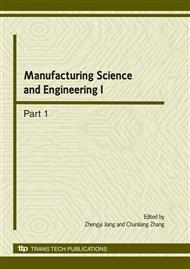p.1138
p.1142
p.1146
p.1150
p.1154
p.1161
p.1166
p.1170
p.1177
Research of Constitutive Relation of Metal Powder in High Velocity Compaction
Abstract:
Metal powders behave high strain rate, viscous effect and first hardening then softening deformation characteristics during the forming process of high velocity compaction. The characteristics of high strain rate and viscous effect are described by composite nonlinear viscoelastic body which consists of non-linear spring, linear spring and high strain rate Maxwell element. The deformation characteristics of first hardening then softening can be described by changing the degree of the term of nonlinear spring from greater than 1 to less than 1. Constitutive relation of metal powder in high velocity compaction is established. The degree of the term of nonlinear spring is considered as a function of strain. The function is approximated by linear, quadratic and cubic polynomial and the stress-strain curves are analyzed respectively. Analysis results indicate that the constitutive equation can describe the deformation characteristics of metal powder in high velocity compaction.
Info:
Periodical:
Pages:
1154-1160
Citation:
Online since:
March 2010
Authors:
Price:
Сopyright:
© 2010 Trans Tech Publications Ltd. All Rights Reserved
Share:
Citation:


